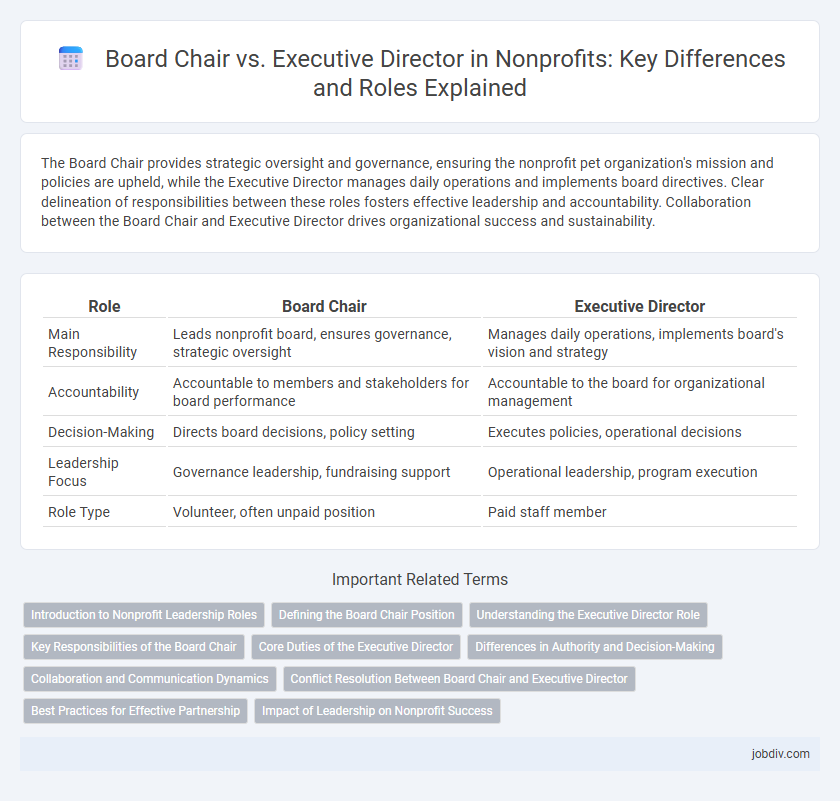The Board Chair provides strategic oversight and governance, ensuring the nonprofit pet organization's mission and policies are upheld, while the Executive Director manages daily operations and implements board directives. Clear delineation of responsibilities between these roles fosters effective leadership and accountability. Collaboration between the Board Chair and Executive Director drives organizational success and sustainability.
Table of Comparison
| Role | Board Chair | Executive Director |
|---|---|---|
| Main Responsibility | Leads nonprofit board, ensures governance, strategic oversight | Manages daily operations, implements board's vision and strategy |
| Accountability | Accountable to members and stakeholders for board performance | Accountable to the board for organizational management |
| Decision-Making | Directs board decisions, policy setting | Executes policies, operational decisions |
| Leadership Focus | Governance leadership, fundraising support | Operational leadership, program execution |
| Role Type | Volunteer, often unpaid position | Paid staff member |
Introduction to Nonprofit Leadership Roles
The Board Chair oversees the nonprofit's governance, ensuring strategic alignment and accountability, while the Executive Director manages day-to-day operations and implements the board's policies. Together, they collaborate to drive the organization's mission, balancing oversight with executive management. Understanding their distinct responsibilities supports effective nonprofit leadership and sustainable impact.
Defining the Board Chair Position
The Board Chair leads the nonprofit's board of directors, ensuring effective governance, strategic oversight, and board member engagement. This role involves setting meeting agendas, facilitating discussions, and serving as a liaison between the board and executive leadership. The Board Chair focuses on big-picture responsibilities, distinct from the Executive Director's operational management role.
Understanding the Executive Director Role
The Executive Director serves as the nonprofit's chief executive officer, responsible for implementing the board's strategic vision and managing daily operations. This role demands strong leadership in fundraising, staff supervision, program development, and financial management to ensure the organization's mission is effectively fulfilled. Understanding the Executive Director's duties clarifies the division of responsibilities between governance by the Board Chair and execution by the Executive Director.
Key Responsibilities of the Board Chair
The Board Chair holds primary responsibility for leading the nonprofit's board, ensuring effective governance, and facilitating clear communication between the board and the Executive Director. Key duties include setting agendas, presiding over meetings, overseeing board member recruitment and development, and upholding the organization's mission and strategic direction. The Chair also plays a pivotal role in supporting the Executive Director's accountability and performance evaluation to drive nonprofit success.
Core Duties of the Executive Director
The Executive Director is responsible for the day-to-day management of the nonprofit, overseeing program implementation, staff supervision, and operational budgeting. This role ensures alignment with the organization's mission by executing strategic plans approved by the Board of Directors. Unlike the Board Chair, who focuses on governance and policy, the Executive Director drives organizational performance and stakeholder engagement.
Differences in Authority and Decision-Making
The Board Chair holds ultimate governance authority, setting strategic direction and overseeing organizational policies, while the Executive Director manages daily operations and implements the board's vision. Authority flow is hierarchical, with the Board Chair leading board meetings and evaluating Executive Director performance, whereas the Executive Director has decision-making power within operational limits. Clear role delineation ensures effective leadership and accountability in nonprofit organizations.
Collaboration and Communication Dynamics
Effective collaboration and communication between the Board Chair and Executive Director are essential for nonprofit organizational success. The Board Chair provides strategic oversight and governance, while the Executive Director manages day-to-day operations and program implementation, requiring frequent alignment on goals and priorities. Clear role delineation combined with open, transparent dialogue strengthens decision-making, accountability, and mission advancement across the nonprofit.
Conflict Resolution Between Board Chair and Executive Director
Effective conflict resolution between the Board Chair and Executive Director in a nonprofit relies on clear role definitions and open communication channels to prevent misunderstandings. Establishing conflict resolution policies, such as mediation or facilitated discussions, ensures issues are addressed promptly and constructively, preserving organizational unity. Maintaining mutual respect and focusing on the nonprofit's mission supports collaborative decision-making and minimizes power struggles.
Best Practices for Effective Partnership
The Board Chair and Executive Director must establish clear roles and responsibilities to foster a transparent, collaborative governance structure that drives nonprofit success. Regular communication and mutual respect ensure alignment on strategic objectives, enhancing accountability and decision-making efficiency. Implementing formal evaluation processes and shared goal-setting strengthens trust and cultivates a dynamic partnership critical for organizational impact.
Impact of Leadership on Nonprofit Success
The Board Chair sets strategic vision and ensures governance, while the Executive Director manages daily operations and implements programs, both critical for nonprofit success. Effective collaboration between these leaders drives mission alignment, resource mobilization, and stakeholder engagement. Strong leadership synergy directly correlates with increased organizational impact and sustainability in the nonprofit sector.
Board Chair vs Executive Director Infographic

 jobdiv.com
jobdiv.com